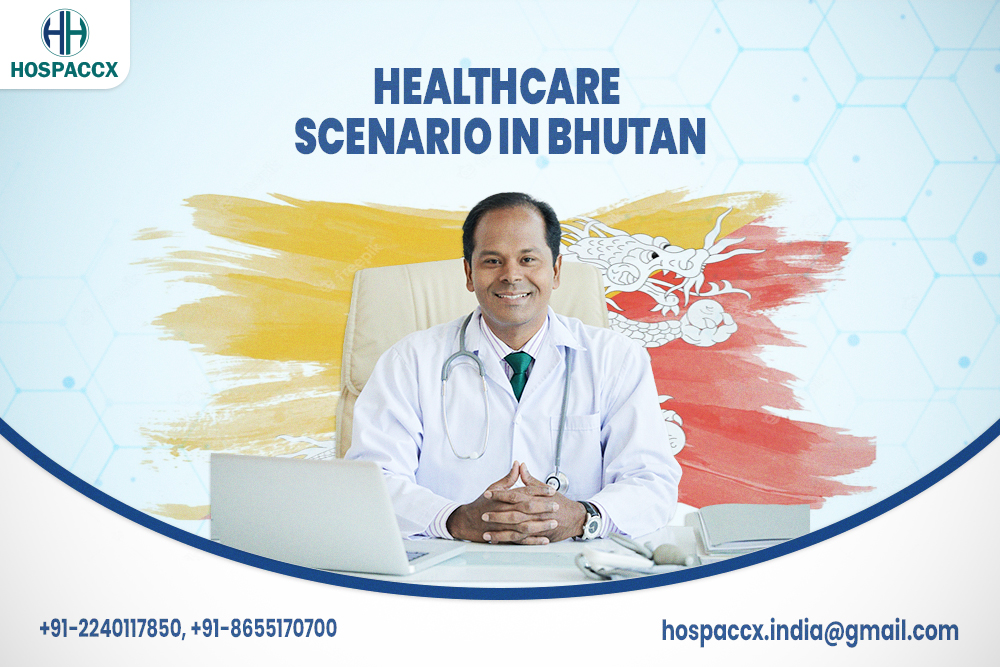Healthcare Scenario in Bhutan
Overview of the country
Bhutan is a small country situated between India and Tibet, east of Nepal, and north of Bangladesh, surrounded by the Himalayas. The country is somewhat smaller than Switzerland, with a total area of roughly 38,400 square KM.
In 1961, Bhutan’s route to modern health care began with two hospitals, two doctors, and two nurses, coinciding with the country’s first five-year development plan (1961-1966). Bhutan has made great improvement in terms of population health and well-being since then. Bhutan met the majority of the Millennium Development Goals (MDGs) in 2015, and all health-related indicators improved.
There has been a shift in illness trends as the country has evolved, both in terms of economy and social indicators. While most vaccine-preventable illnesses are declining, with certain diseases, such as polio, being eliminated or eradicated, new infectious diseases, such as HIV, dengue fever, and multidrug-resistant tuberculosis, are emerging (MDR-TB).
Demographics
Bhutan has a population of 7,87,780 ( est 2022) and a growth rate of 0.99% .It has a birth rate of 16.17 births per 1000 population, a death rate of 6.28 deaths per 1000 population, and life expectancy of 71.5 years (male 70.1 years, female 72.98 years). The fertility rate in Bhutan is 1.8 children born/woman in 2020, and infant mortality rate of 35.99 deaths/1,000 live births live births. Their sex ratio is 1.08 males to 1 female. Maternal mortality ratio is 183 deaths/100,000 live births and its position in the Universal health coverage (UHC) service coverage index, 2019 is 62.
Health Care System in Bhutan
Healthcare in Bhutan falls under the Ministry of Health (MoH). The MoH aims to achieve universal health coverage by improving access to quality and equitable health services, strengthening preventive, promotive, curative, rehabilitative and palliative health services, and promoting efficiency and effectiveness in the financing and delivery of health services. Its vision is “a nation with the best health”. Basic public healthcare is free, as reflected in the Constitution of Bhutan: “the State shall provide free access to basic public health services in both modern and traditional medicines”.Healthcare is delivered to the citizens of Bhutan through 49 hospitals including the National Traditional Medicine Hospital (NTMH), 186 Primary Health Centres, 53 Sub-posts, 542 Outreach Clinics (ORCs), three Thromde Health Centres, and five Health Information and Service Centres. There are 5,901 healthcare workers who cater to its population of 857,423.
Bhutan’s health services are organized in a four-tiered network, which is made up of the National Referral Hospital, regional referral hospitals, district hospitals, basic health units, and outreach clinics at the local level. The health service units on the lower levels depend mainly on local authorities and administrators for their support, who in turn, report to the health department at the national level.
Traditional and allopathic medicine services are fully integrated and delivered under one roof. At the grassroots level, village health workers (VHWs) play a key role in health promotion and act as a bridge between health services and the community.
Health Statistics
In 2019, Bhutan’s health facilities stood at 3.9 per 10,000 people. Similarly, in 2019, the doctor-to-population ratio was 0.5, which is 50% lower than the WHO-recommended ratio of 1 doctor per 1000 people. The nurse-to-population ratio is 18.4 per 10,000, which is lower than in other Southeast Asian nations. From 1.7 in 2012 to 1.1 in 2019, the number of beds per nurse has decreased.
Increase in Geriatric Population
Between 2005 and 2017, the crude birth rate fell from 19.7 to 15.5 per 1,000 people, while the crude death rate fell from 7.1 to 6.7 per 1,000 people. Life expectancy has more than doubled in the last five decades, from 32.4 years in 1960 to 70.2 years in 2017. Between 1994 and 2017, the Total Fertility Rate (TFR) fell below the replacement rate, falling from 5.6 to 1.7. While Bhutan’s population is relatively youthful, with a median age of 26.9 years, the country’s dropping TFR and death rates are raising worries about population ageing and reliance. Approximately 6% of the population is above the age of 65, and the proportion of the elderly population is predicted to grow. The overall dependence ratio is 47.0, which means that for every 100 economically active people, 47.0 people are reliant on them.
Improved Maternal Indicators
In 2019, nearly all pregnant women attended at least one prenatal care appointment, compared to only 51% in 2000, and over 54% attended more than eight antenatal care visits last year. From a low of 10% in 1994 to over 94 percent in 2019, institutional delivery coverage has increased dramatically. For the past ten years, countrywide vaccination coverage has remained at >95 percent.
Disease Burden
Overall, despite outstanding achievements in health systems performance and health outcomes, the country faces multiple burden of health challenges. While communicable diseases remain a substantial burden, NCDs are increasing. A few other emerging, challenging issues are crime, substance dependence and suicide/other mental health problems. Bhutan is also prone to natural disasters and hazards such as earthquake, landslides, floods and outbursts of supraglacial lakes.
The leading risk factors accounting for the most disease burden are dietary risks, high blood pressure and household air pollution from solid fuels (Institute for Health Metrics and Evaluation, 2017). 13.5% of the adult Bhutanese population (18–69 years) had three or more of the modifiable NCD risk factors. Salt consumption is very high, almost double the WHO recommended limit. Alcohol intake is also very high, with 42.4% of the population being current drinkers while 22.4% binge drink. Although the incidence of smoking is low (7.4%), the use of smokeless tobacco is very high at 19.7%.
Healthcare Financing
Health services are free as enshrined in the Constitution of Bhutan. Therefore, government revenue is the predominant source of health financing. Total health spending as a percentage of GDP has been stable over time, at roughly 4%, with the government accounting for 70% of current health spending in 2016. Healthcare spending per capita has risen steadily over time, from Nu. 1400 in 2000-2001 to Nu. 7,512.00 in fiscal year 2015-2016. Health-related out-of-pocket spending has steadily increased from 11 percent in 2010 to 12 percent in 2014, and 20 percent in 2016.
For decades, foreign aid has been crucial in subsidising Bhutan’s healthcare, accounting for as much as 30% of total health spending in 1996. However, during the last few years, its proportion has been declining, with the most recent figure being approximately 9.5 percent. On the other hand, the Bhutan Health Trust Fund (BHTF) is gaining significance in assisting Bhutan’s healthcare finance, with its part increasing from 0.042 percent in 2010 to 5.14 percent in 2014. With the eventual phase-out of conventional contributors, the role of BHTF is projected to grow in the future years.
Health Care Infrastructure in Bhutan
Public Sector
- Mongar Regional Referral Hospital, Bhutan: A tertiary multi-specialty healthcare institution in eastern Bhutan, the hospital serves as regional referral hospital for the region, as well as a technical backup centre for the hospitals in the east. Committed to providing preventive, pro-motive, curative and rehabilitative healthcare, the hospital’s practices are based on evidence-based and holistic approaches. The hospital’s departments include orthopaedics, ophthalmology, general medicine, gynaecology and dentistry.
- Jigme Dorji Wangchuck National Referral Hospital, Bhutan; Named in honour of the third King Jigme Dorji Wangchuck, the hospital has been serving the people of Bhutan for a long time. With 350 beds, the hospital has several specialisations such as general medicine, general surgery, orthopaedics, psychiatry, dermatology, gynaecology and paediatrics.
- Central Regional Referral Hospital, Gelephu: One of the 3 Tertiary Care Hospitals of Bhutan, CRRH Gelephu caters to the people of 6 Central Districts of Bhutan.
- The Institute of Traditional Medicine Services: This is based in Thimphu, the capital of Bhutan, located on a hilltop above the Traditional Arts Centre and the National Library. The institute supplies traditional medicines and medical services, trains doctors, and conducts research on traditional medicinal plants to identify the ingredients and develop new products.
Private Sector
In terms of private-sector health care, the government pushed the creation of high-end hospitals in the private sector to provide high-end health care that public hospitals could not give. However, this has yet to be achieved, and patients who are unable to be treated at national referral hospitals are directed to Indian hospitals. Other attempts, such as the development of selected diagnostic centres by private companies, were permitted by the government in 2014.
Since the 1970s, the Bhutan government has offered free universal healthcare to all its citizens. Barring one private health clinic in the capital of Thimphu, there are no private physicians or clinics. There are more than 30 hospitals across Bhutan. Except Gasa, every district (known as dzongkhags) has at least one government hospital. Thimphu has 5 hospitals. The districts of Chukha, Samtse and Trashigang have 3 hospitals each. Each district has several smaller healthcare centers and medical facilities, while an indigenous hospital facility is available at Thimphu. Currently, 14 chosen diagnostic health centres are located in the country’s largest cities.
- Menjong Diagnostic Centre, Thimphu- In 2018, Menjong conducted more than 2500 endoscopy and colonoscopies (those with stomach and colon problems) and 2600 ultrasounds which could detect stones, cancer, etc and help patients get treated properly. In 2018, Menjong Diagnostic Centre received 7,688 patients.
- Padkar Diagnostic Centre, Thimphu- Established in 2015, the centre received 4,267 patients in 2018. The diagnostic centre and private clinic offers services like endoscopy, ultrasound, ECG, blood, urine and stool test services.
Conclusion
Bhutan’s progress in increasing its people’s health and happiness, as seen by numerous indices, is noteworthy. The GNH indicator can be used as a gauge of progress. Despite these accomplishments, much more work needs to be done to strengthen GNH in Bhutan. This involves eradicating poverty, closing the socioeconomic divide, combating developing and re-emerging infectious illnesses, and stemming the rising tide of mental and lifestyle-related ailments. As a result, how the health system is remodeled to address these challenging issues in the context of the modern Bhutanese population’s growing expectations will affect happiness indicators, and how Bhutan strives for economic growth without compromising its people’s well-being could exemplify the modern developmental paradigm.
For more information about the Country and Healthcare opportunities in Bhutan, you can visit the company website on www.hospaccxconsulting.com or contact us directly.
Related Team Members
Related Services
Other Industries
Related Blog
Related Success Stories










